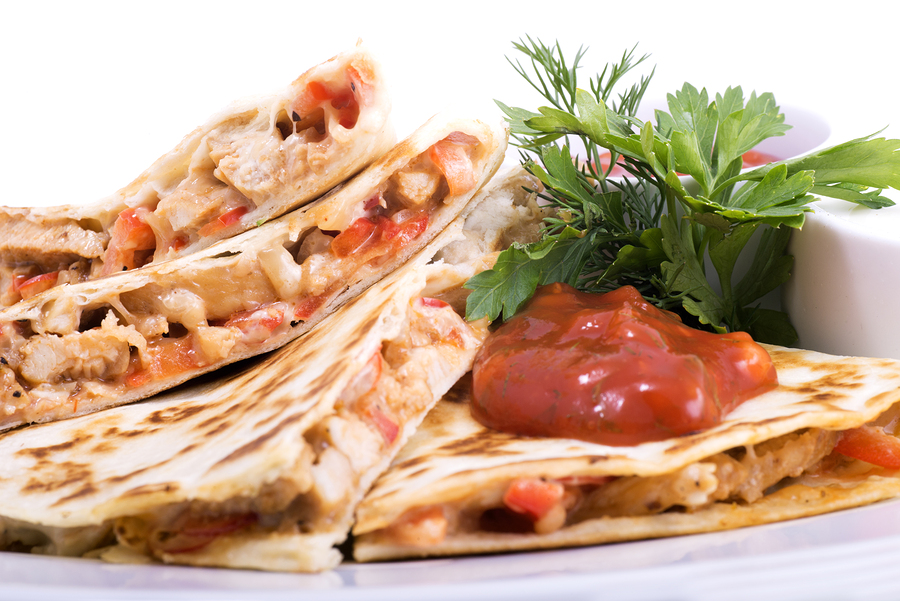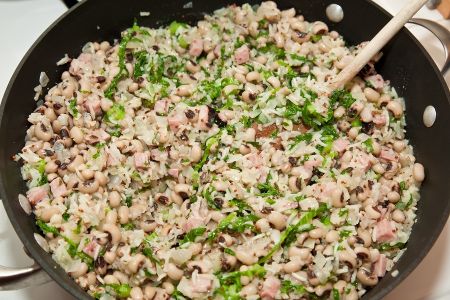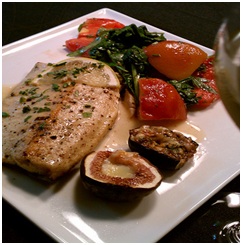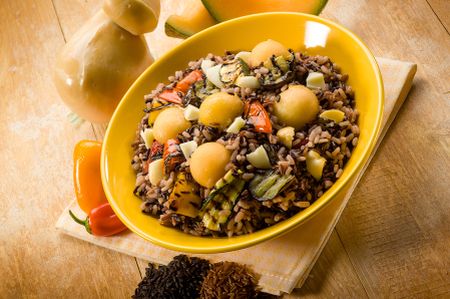An easy-breezy, cheesy-pleasy solution for leftovers and fast meals. Simple to multiply for several people or a larger serving. If you’re a fan of melted cheese and generally short on time, keep a closed container of shredded cheese freezer, ready to use.
Click to get more Easy, Healthy Recipes
Preparation Time
7 minutes
Cooking Time
10 minutes
Difficulty Rating
1
Health Level
4
Serves
1

Ingredients
- 1 medium (8-in / 20-cm) whole grain tortilla
- ⅓ cup / 47 g skinless chicken, cooked and chopped or sliced
- ¼ cup / 28 g shredded cheese, preferably organic pastured
- ¼ cup / 37 g red or green sweet bell pepper, chopped or sliced
- Seasonings of choice (optional)
- 1 tsp. / 5 ml olive oil
Directions
- Preheat oven on broil setting, unless using toaster oven
- Brush a small space of a baking sheet or toaster oven tray with most of the olive oil
- Place chicken breast, cheese, and pepper pieces, along with seasonings if desired, on one half of one side of the open tortilla, then close the tortilla.
- Place the closed tortilla on the oiled baking surface, and brush the remaining olive oil on the side facing up.
- Broil or toast the quesadilla until the the inside is soft and the surface is golden brown, about 5-10 minutes.
Serving size: 1 quesadilla
Exchanges per Serving: 1 Carb, 3 Protein, 1 Fat




Is there a way to add this to my meal plan? Also if there is something I am wanting to make and its not on the meal plan made for me, is there a way to add it?
Hi, sdavis. You can just use certain recipes instead of the meal in your menu, if the recipe isn’t included in the list of alternatives (you can see a list when you click on an item you wish to replace).
Note that this particular recipe is not keto-appropriate, so you would need to modify it to make for a good fit – use a wrap from this recipe in place of the tortilla: https://www.trimdownclub.com/recipe/flaxseed-sandwich-wrap/.
Can we add onion in addition to the pepper?
Hi, regansmom. Definitely! Vegetables are always a good idea 🙂
Hi, RuthAndDrew. I would be happy to help. What translations would you like?
This is lovely and easy to do. Need a few translations from American into English.
If it’s the cup measurements you need changing you can actually get cup measurers from places like home bargains or the range, I got mine from poundland. Hope this helps
Hi, Theresa. Absolutely! Up to 4 tablespoons of, salsa is “free” and more than that makes it a vegetable exchange; each 2 tablespoons of avocado is is a fat exchange.
Can we supplement this recipe with avocado and salsa?
sounds delicious, will try it tomorrow
Hi, Lacey. Our tech development team is currently working on that. In the meantime, I recommend creating a designated folder in your regular internet browser.
Have your techs made it possible to save our own favorite recipes within this site?-please advise.
Hi, swtpeas. For those already in the Menu Planner application, you can “heart” them as you go through the lists making you selections. We are working on the remaining newer recipes.
Is there any way to save our favorite recipes, or a quick way to get back to them?
Sounds very good and easy!
Hi, nsdixon. Actually, “5” is the healthiest – so “4” is pretty good. Many of our recipes are already in the Menu Planner application – just scroll down to “Recipes” in each major category. Newer recipes, such as this, can be swapped in for something similar – for example, 3 ounces of meat or cheese plus a carb (a small chicken fillet plus half a cup of pasta).
Hi, Danny. You don’t have to order out. If you are using the Menu Planner application, you can select foods that are quick, like homemade sandwiches or quesadillas, nuts, fruits and vegetables, etc. – the following are some general ideas:
• Fresh and dried fruit
• Cut raw vegetables
• Oven-baked vegetable chips
• Nuts and seeds
• Trail mix combinations of nuts, seeds, and dried fruit
• Sandwiches – good breads with nut butters, hummus and similar spreads, tahini, canned or smoked fish, cheese, homemade “cold cuts” from fresh meats, egg salad, etc.
• Whole grain or Paleo crackers plus any of the above
• Hard-boiled eggs
• Sliced or string cheese
• Cottage cheese
• Yogurt
• Milk (dairy or vegetal), plain or flavored with cocoa powder and a recommended sweetener
• Hearty soup in a thermos (2-3 food groups, i.e. meat or legume, vegetable, whole grain)
• Hearty smoothie/shake in a thermos (2-3 food groups, i.e. fruit/vegetable, dairy/vegan, seeds)
• Edamame or other legume/pulse snacks
• Whole grain or Paleo cereal or granola (cold in small sealable bag, cooked in thermos)
• Canned beans
• Prepared healthy foods in containers – from leftovers or prepared the night or weekend before.
• Homemade whole-food muffins or bars
• Popped grains, i.e. organic popcorn, sorghum, quinoa
You can even have your wife prepare meals ahead – soups are good for this, and there are many of our recipes that can be frozen and reheated.
In any event, the following are some tips for ordering out:
• If you can, get online to search for the ideal place ahead of time, filtering the options by features. Look for restaurants with an emphasis on whole foods, including vegetables and even ‘slow’ cooking – or at least a de-emphasis on junk food, deep-fat frying, heavy sauces, and rich sweets.
• If you know in advance where you’re going, peruse the menu ahead of time and prepare yourself with the right choices. The usual wisdom applies here: salads, cooked or ‘hidden’ vegetables (i.e. red sauce and salsa), baked or sautéed entrees, light sauces, and fruit for dessert. Or if nothing else, “prepared how you like it”.
• Avoid the bread or chip basket, or any other ‘empty calorie’ filler that a restaurant may offer before a meal. This will add a whole new course that you hadn’t anticipated, usually made up of refined carbohydrates an undesirable oils. This can be diet sabotage, so kindly ask the server in advance to leave the breadbasket or chips and salsa off your table, so you are not tempted. If you order unsweetened tea or water with lemon in advance for sipping, you may not miss it. When it comes to the real food, eat bulky, low energy-density (a.k.a. ‘low-calorie’) foods first, generally high in water and fiber – order a salad or clear soup as your first course, and when dinner arrives, start with the lightest foods on your plate, usually the vegetables.
• Don’t be shy about asking how your food is prepared. They are there to serve customers, of which you are one. Even if your server doesn’t know, the cook does, and if you do, you can take it or leave it – or improve it. Find out if butter, margarine, or oil is used, and what is available for substitution. Ask about the sauce that comes with an entrée, and if it has “cream”, “butter”, or “cheese” at the core – then go with a healthier alternative.
• Look for foods on the menu that are broiled or grilled (but not charred or blackened), poached, steamed, roasted, or baked; avoid foods that are fried, crispy, creamy, creamed, au gratin, escalloped, or breaded – all of which are synonyms for high amounts of added fat prepared in an unhealthy way.
• Balance is key. If you really want a high-calorie item, balance it out with lighter choices for the rest of the meal.
• Every food has a healthier version. Order the leaner type or cut of meat, and exercise portion control (take advantage of the doggie bag, and only eat half if the portion is too large). If you love fish and chips, then try grilled fish and oven-fried potatoes, etc. Substitutions can usually be made. Here are some healthy choices you can make at different types of restaurants:
– At a pizzeria, choose a plain cheese pizza (not ‘extra’ cheese) with a plain crust (not ‘stuffed’), or pizza with vegetable toppings instead of meat toppings, such as ‘Margarita’ with fresh tomatoes.
– In an Italian restaurant, if you like chicken, veal, or eggplant parmesan, try grilled chicken or eggplant with marinara sauce and a sprinkle of parmesan cheese. Ask for oil and vinegar on the side to dress your own salad. Order pasta with red sauce such as marinara, instead of such creamy white or butter sauces as Alfredo. Mushrooms make a great low-fat meat alternative. Have sorbet or a cappuccino for dessert instead of rich cake – unless you’re splitting it 4 or more ways.
– In an Asian restaurant, choose steamed rice instead of fried rice – brown if you can get it! – steamed dumplings or vegetables instead of fried egg rolls or tempura, as well as vegetarian entrees that include a number of different vegetables instead of meat; particularly avoid deep-fried entrees such as lemon chicken and ‘sweet-and-sour’ pork or chicken. Be sure to avoid monosodium glutamate (MSG), which can work against your weight and health goals, and opt for low-sodium soy sauce. Have a salad or clear/miso soup as a first course.
– In a Mexican restaurant, choose salsa instead of sour cream or cheese dips; avocado is a great source of ‘good’ fat, but it is still quite dense, so go easy on it. Choose dishes made with plain, soft tortillas that aren’t fried, such as burritos, soft tacos and enchiladas. Have baked instead of refried beans.
– In a cafeteria or food-buffet restaurant, fill your plate with plain vegetable side dishes before you go for the heavier items. Look for grilled, broiled or flame-cooked chicken, fish, and lean meats or tofu, and avoid anything breaded, batter-dipped or fried. If there’s a salad bar, concentrate on crisp, crunchy vegetable and bean mixtures; leave the potato, macaroni and tuna salads behind. Avoid going back for seconds on all items except vegetables, and be sure to use dressings sparingly unless naturally light, such as lemon juice and/or vinegar.
• If you want a salad with dressing on the side, ask for it. If the house dressing is too rich, oil and vinegar are almost always available, at least upon request. Vegetables can always been steamed instead of fried, and lemon and spices added instead of butter. If you want your chicken grilled instead of fried or smothered, go for it. The same goes for marinara sauce instead of the regular cream-based sauce. You get the idea.
• Stick with sound serving sizes, though sometimes this is easier said than done. Many restaurants, especially the ‘affordable’ ones, make it a point to fill your plate to give you a sense of value. Though this seems like a good idea, be aware that it can take up nearly your entire daily allotment for fat and/or energy. Cut your ‘gains’ right away, and divide your restaurant portion into two – share with a dining partner, or just eat half there and pack the other half to go – in this way, you avoid the problem of eating too much and paying for it later. If you know you’ll be tempted to eat more than you should, ask to have your ‘doggy bag’ prepared in advance, so you’ll only get a sensible portion size at the table. Some restaurants will even let you buy a half order or children’s portion of an entrée.
This recipe is health level 4. Is level 1 the most healthy.
How do I get a recipe to come up only menu?
Delicious! Will try again, quick and easy.
i AM A MAN AND i DO NOT PREPARE MY MEALS PARTICULARLY FOR BREAKFAST AND LUNCH MY WIFE WORKS SO SHE IS NOT AVAILABLE TO PREPARE THE SPECIAL MEALS YOU ARE SUGGESTING i EAT. wHAT DO I DO ? CAN I ORDER CHICKEN QUESADILLAS AT MY REGULAR MEXICAN FAST FOOD RESTAURANTS ? iF YES, WHAT DO i TELL THEM WHEN ORDERING ? lET ME KNOW ASAP i AM HUNGRY NOW AND i NEED TO EAT LUNCH SOON THANKS.
DANNY SOUDER DSOUDER3@GMAIL.COM